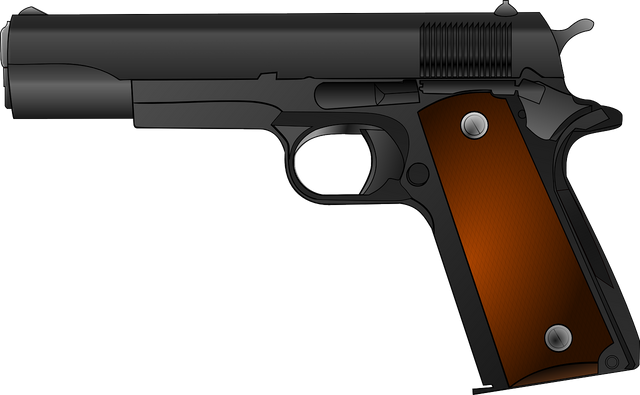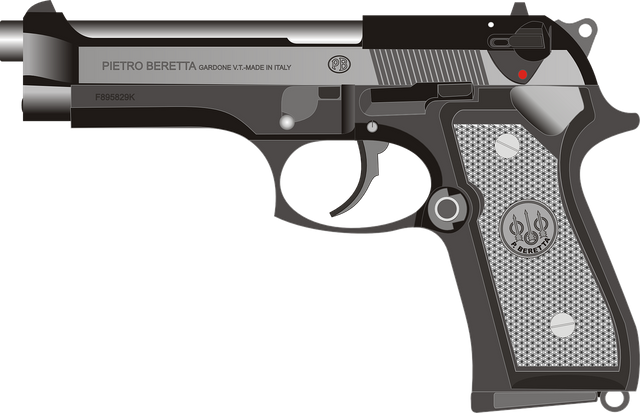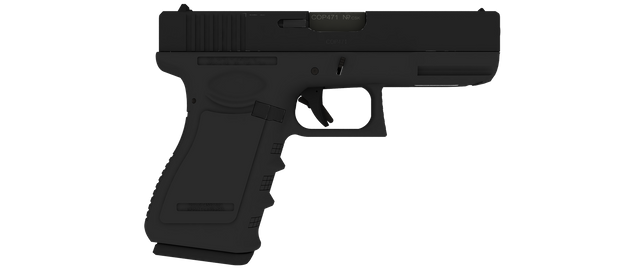Semi-Automatic Pistols
In the late 1800s, roughly concurrent with the development of double-action revolvers, gunsmiths also began developing the first semi-automatic handguns. There are a number of terms applied to these designs, including self-loading pistol, automatic pistol, and autoloader. Note that these terms do not refer to fully-automatic machine pistols. They all just mean that the firearm uses some of the energy from firing a round to:
- Extract the spent casing of a fired round from the chamber
- Eject that empty casing from the gun
- Load a fresh cartridge from the magazine into the chamber
- Ready the gun to fire again
A machine pistol also fires the next round, starting the sequence over again until all ammunition is expended or the trigger is released. That kind of firearm is not the subject of this post. Contrary to a common misconception, such fully-automatic firearms are indeed heavily taxed and regulated in the United States. Machine pistols, submachine guns, assault rifles, and light/heavy machine guns are all incredibly rare, and are not readily available through local gun shops. But that is getting away from the point of this post. All you need to know is that the term semi-automatic is generally used today to refer to modern pistols because they automatically cycle the action, but do not automatically continue firing. The other terms may also be seen from time to time, but they all mean the same thing.
Operation
There are several means by which semi-automatic handguns operate. These are the two most common.
Blowback
Simple Newtonian physics apply here. As the powder from a fired cartridge rapidly burns, it generates gas pressure that thrusts the bullet forward at high velocity. This pressure also thrusts the cartridge back with the same force, where it presses against the far greater mass and spring tension forces of the pistol bolt. This pressure cycles the bolt back until travel is arrested. pulling the empty fired case along with it. The case is ejected, and as spring pressure forces the bolt closed again, it pulls a new round from the magazine and feeds it into the chamber. The limiting factor for this design is the power of the cartridge. To control the recoil forces of higher-powered cartridges, much more mass and spring tension are required to control the blowback operation. This results in heavy, cumbersome firearms as power increases. Blowback pistols are more commonly used for small-caliber pocket pistols and target pistols.
Short Recoil
The mechanisms to achieve this form of action vary, but the barrel recoils along with the bolt for a short distance before a toggle or cam allows the barrel to separate and stop while the bolt continues to cycle as in a blowback-operated firearm. Because the barrel and bolt are coupled briefly, it allows the gas pressure from higher-powered rounds to drop after the bullet leaves the barrel before the barrel allows the breech to open. Most modern pistols designed for military combat, police issue, and self-defense in caliber 9mm or greater use some form of short-recoil operation due to the gas pressures and recoil forces involved.
Action
Semi-automatic pistols can generally be separated into single-action, double-action, and striker-fired actions.
Single-Action
As with revolvers, a single-action trigger in a semi-automatic pistol only releases a hammer to strike a firing pin and fire a round. The hammer must be cocked first, and these are often carried with the hammer cocked and a mechanical safety activated. Triggers are typically a crisp and light compared to the other action types, and this makes accurate shooting easier. The Colt 1911 and its derivatives are the iconic single-action semi-auto.

Image credit
Double-Action
Again, as with revolvers, the trigger can cock the hammer as well as drop it to fire a round as a single trigger press, performing two actions. Double-action semi-automatics are usually carried with the hammer not cocked. This requires much more force to pull the trigger for the first shot, and subsequent shots are typically lighter like those of a single-action, since the operation of the firearm re-cocks the pistol and removes the need for the heavy trigger pull. The peculiarity of two very different trigger pulls is seen as a detriment by some, but the extra force required for the first shot and the firearm being carried un-cocked is seen as a safety feature by others. Needless to say, this is a divisive topic among firearm enthusiasts. The Beretta M9/Model 92 shown here is an example of a double-action semi-auto.

Image credit
Striker Action
Instead of using the rotating mass of a hammer to strike a firing pin, striker firearms use a heavier striker to fire rounds. This striker moves in a linear path under spring tension, and the trigger releases the striker directly. This is a mechanically simpler design requiring fewer moving parts. The trigger press is consistent from shot to shot, unlike a double-action pistol. It is carried cocked, but there is usually no need for an external safety since there is no hammer to retain, unlike a single-action. While striker-fired pistols are not a new idea, the Glock 17 of the 1980s unleashed a horde of imitators, and as a result, there are many options for striker-fired pistols on the market today including Glock.

Image credit
Calibers
The number of calibers available for any type of firearm is overwhelming, and semi-automatic pistols are no exception. Unlike revolvers, there are few (if any) calibers that can be safely interchanged in the same pistol, because not only does the bullet diameter need to match, but semi-automatics also need a certain range of recoil power to operate reliably and safely. There are some models that can swap barrels and recoil springs in order to convert calibers, but I would generally advise someone to avoid them. Get the right gun in the first place and practice.
Below are a few common calibers, their general applications, and my opinions about them. As always, I am not an expert, and there are differing opinions out there.
.22 LR
Many excellent target pistols are available in this caliber, and it is popular for target shooting, small game hunting, and pest control. It is not generally advised as a self-defense or combat caliber due to its low power, but it must still be treated with the same respect and caution as any other ammunition.
.25 ACP
This is an old round, and while it remains available, it is not especially common. It isn't much more powerful than .22 LR, and ammunition prices can be excessive. I would advise against buying a gun in this caliber in the United States. International shooters would need to chime in with their perspectives.
.32 ACP
This is also an old round, it is also not especially common. It is more powerful than .22 LR and .25 ACP, but ammunition prices are high and availability low. The advantage the .32 once held has been eclipsed by modern subcompact .380 and even 9mm pistols today. I would again advise against buying a gun in this caliber in the United States, but overseas gun owners would need to consider their local laws and markets.
.380 ACP
Here is the threshold for minimum defensive ammunition power according to many gun gurus. The 9mm Short is a very popular pocket pistol caliber for self-defense and concealed carry as I wrote this post. It is generally the largest caliber used in blowback pistols. Options for modern .380 pistols are almost endless. I have heard that in many countries, it is illegal or very difficult to buy a firearm in military calibers, and as such, this round may also be an option for many outside the USA.
9mm Parabellum
This is the NATO standard for sidearms and submachine guns, and it is incredibly popular among civilian gun owners in the United States, too. Modern metallurgy, polymers, and firearm designs have allowed 9mm handguns to be made ultra-compact for concealed carry self-defense, and the dimensions of the cartridge make it eminently suitable for modern full-size combat pistols with magazine capacities of 15-18 rounds, too.
.40 S&W
A shortened derivative of the 10mm Auto, the .40 S&W is a popular alternative to 9mm among police departments and civilian shooters alike. It is more powerful than 9mm, but offers some of the capacity advantages of 9mm as compared to the larger .45 ACP. It is a sort of middle ground. Personally, I am not a fan, but I have friends who disagree with me.
10mm Auto
OK, this isn't especially common, but as I write this, it seems to be seeing a resurgence in popularity. I have fired a couple 10mm handguns, and I very much want one. This round can be more powerful than a .45 ACP while also offering higher magazine capacity. It could be a very good bear country gun. The only real downsides for me personally are the cost of the firearm, the cost of the ammunition, and the scarcity of ammunition at retail.
.45 ACP
Technically, this round is more modern than the 9mm Parabellum, but it has a reputation in some circles as old and obsolete. In other circles, it is as American as baseball and apple pie, so shut your damn mouth, whippersnapper! The best-known .45 is the Colt 1911 pistol used by the US military through World War I, World War II, the Korean War, and the Vietnam War. It is more powerful than 9mm, and in jurisdictions with magazine capacity limits imposed by law, there is often a sentiment of, "well, if I can only have X rounds, might as well make 'em big ones!" Even where there are no limits on capacity, many shooters prefer the ergonomics of the 1911 and plan to either make their shots count or plan to reload more often should they face a really Big Problem.
So which is the best?
I plan to have a summary post at some point with several key considerations for prospective firearm buyers, but the short answer is, there isn't a "best gun." There are better or worse guns for a given shooter. In general, I advise visiting a shooting range where you can rent various guns and see what you like. What is comfortable for you to shoot? What can you shoot most accurately? What can you afford to buy and maintain?
I personally dislike Glocks, but I must admit that the generic answer of, "Get a Glock 19 and practice a lot" is still sound advice that can cover most needs. That particular striker-fired short-recoil 9mm is large enough to offer good capacity and good sight radius, but small enough to carry comfortably, and even potentially carry concealed. I don't like the way Glock triggers feel, but if I owned one and spent time at the range practicing, I'm sure I could get over it. Glocks are not outrageously expensive guns, and they has a well-deserved reputation for reliability.
I personally rather like the 1911, but even I must admit that it is an older, more complicated design and it requires more practice to carry and use safely and effectively with its manual safety. Again, practice resolves such matters. Turn time and money into skill at the range if you can.
Keep an eye out for future articles expanding on the ideas above, and I may return to edit this post further since it doesn't quite sit right with me at the moment for reasons I cannot quite identify.
Good post to save :-) I prefer the .45 with reduced powder for target practice.
Do you have cycling issues with reduced powder loads?
Rarely ...
10mm auto, Mexican carry. Sorted!
I went through this a couple years ago when I was shopping for my first pistol. Through friends I was able to try a couple 1911's in .45, a .357 revolver and a couple Glock variants in 9mm. Of all the handguns I tried, I actually liked the ergonomics and shooting consistency of the revolver the most, but for various practicality reasons, reloading being primary among them, I decided against getting one for self-defense. I liked the ergonomics of the 1911 the least, although being such heavy guns, even in .45 ACP I didn't notice recoil being much worse than the Glock 9 mm, and they're pretty easy to shoot accurately.
I ultimately settled on the 9 mm and got what many consider to be a Glock knock-off, the S&W SD9, but it's known for being one of the least expensive guns out there, it's super reliable (most reliable semi-auto I've ever fired), and accurate (for a handgun) if you can get over the heavy trigger pull. Some range time and I was able to quickly work around that heavy trigger.
I also liked the price and availability of the 9 mm cartridge, along with its proven track record in police, military and self-defense use. I also like the fact that many rifles have been coming out recently chambered in 9 mm, which would make it a good candidate for inexpensive and low-recoil target shooting at the rifle range without needing to carry multiple calibers of ammunition.
Everyone has their own criteria for firearms, which is why it can be hard to say, "this is the best option for everyone." I plan to discuss pistol-caliber carbines in a future post, and one big advantage can be not only caliber compatibility, but magazine interchangability, depending on the pairing.
I really enjoyed the Glock 22. Bit more serious than the 9mm, without being too cumbersome.
I just don't really like .40S&W though. I am of the opinion that a 9mm loaded with JHP is sufficient for any self-defense scenarios I can envision, and I prefer a .45ACP, .357 mag, or the eventual 10mm Auto I would like to get as a woods gun. The jack-of-all-trades position of .40 S&W just doesn't seem like a good fit for me. YMMV, of course.
Full-sized 1911s are cumbersome to conceal/carry.
I know this from experience.
However, that's what I do.
They do have the advantage of being slimmer than double-stack 9mm pistols, but a full size grip will always be hard to keep discreet.
Sup Dork?!? Enjoy the Upvote!!! Keep up with the dorky content for more love!!!
Hello!
This post has been manually curated, resteemed
and gifted with some virtually delicious cake
from the @helpiecake curation team!
Much love to you from all of us at @helpie!
Keep up the great work!
Manually curated by @blewitt.
@helpie is a Community Witness.